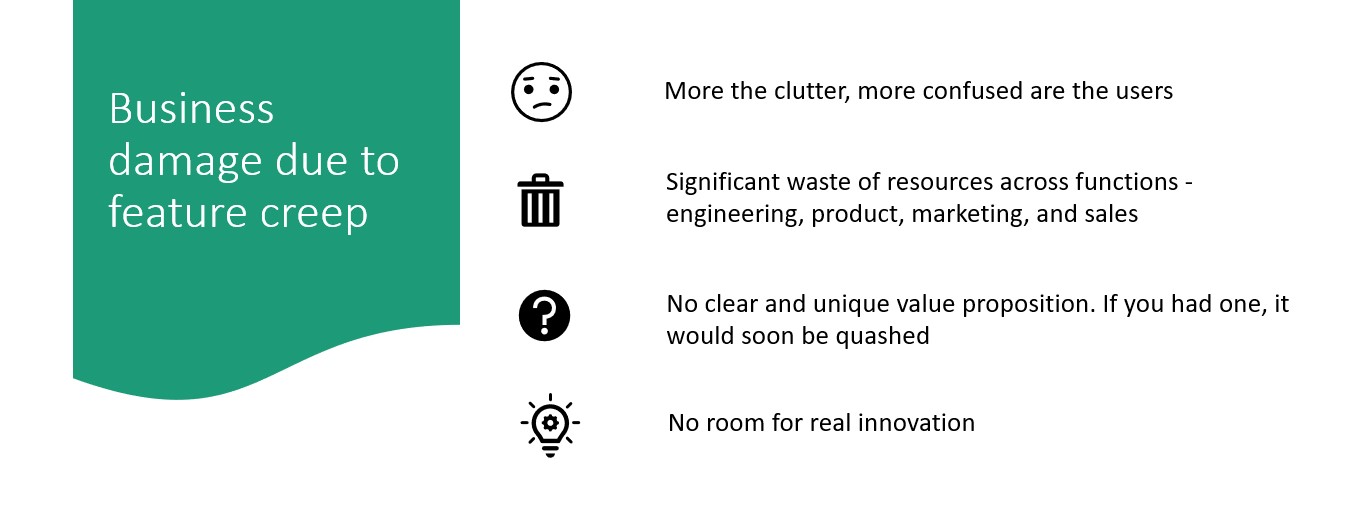Next time you heat the food in your oven or dump the clothes in the washing machine, take a moment to observe the array of available buttons and options. How many of these have you used since the time of purchase? Pick a product that you use at work. How well are you acquainted with most, if not all, of the features it offers? In case you realize that you are using only a small subset of features, despite using the product every single day, be assured that you are not the only one.
‘The value is in what gets used, not in what gets built’ – Kris Gale, Startup Advisor and Investor
Let’s understand this irony from the perspective of both the Product Manager and the Product User.
It is common for a Product Manager to roll out product roadmaps stuffed with features. It happens across all kinds of organizations in almost an autopilot mode. Release after release, organizations look up to them for innovation which is obviously not easy. Hence, the normal tendency is to ‘throw stuff at the wall and see what sticks’ which gradually negates the product value and the user experience. The product ecosystem in general is tuned to work this way. Consequently, products get loaded with meaningless features.
What does it mean to the users?
- Users don’t care
In my experience of more than a decade in building and selling enterprise software products, I have seen that users don’t really care about anything new until it directly impacts their work. As a matter of fact, all of us are just fine in using the same set of features in the same way to accomplish our daily tasks especially at work. It isn’t easy to overcome the user inertia with product trainings and promotional offers. Why fix something which is not broken?
- Features are not easily discoverable
The product isn’t giving adequate signals to the user on what all can be achieved. What a colossal waste of time and money if the feature can’t be discovered!
- Not usable
Often the engineers and designers think and build features based on their perspective and believe that they are simple and usable. However, the context in which the product is used can be very different – who (user competence), where (external conditions), how (device, browser)
‘Design is really an act of communication, which means having a deep understanding of the person with whom the designer is communicating’
– Donald A Norman. The Design of Everyday Things
- Not enough communication and user training
Product managers don’t do enough to creatively communicate to the users and motivate an action. Emails and banners are not enough in the current world where zillions of tools and vendors are vying for user’s attention.
It harms the business in multiple ways

How to overcome this predicament?
‘Perfection is achieved, not when there is nothing more to add. But when there is nothing
left to take away’
- Antoine de Saint-Exupery, a French writer and pioneering aviator
A great product manager is a Minimalist who is exceptional at looking past meaningless features to focus on adding real value to the users. To build this flair it is paramount for the product manager to
- Closely collaborate with customers and partners, follow the industry and technology trends
- Validate the feature-value hypothesis continuously with a good mix of customers
- Don’t add a feature just because the competitive product has it. Instead, divert the attention on what customers value
- Design the user experience (UX) such that the users can discover a feature effortlessly, feel motivated to use it and reap the benefits
- Ruthlessly prioritize and communicate the rationale to cross-functional teams
To conclude, a minimalist product manager is a fearless visionary who channelizes the energy and investment on innovation which matters to the customers.
‘A great product manager has the brain of an engineer, the heart of a designer, and
the speech of a diplomat.’ – Deep Nishar, SoftBank Investment Advisers
Disclaimer: The views expressed in the article above are those of the authors’ and do not necessarily represent or reflect the views of this publishing house. Unless otherwise noted, the author is writing in his/her personal capacity. They are not intended and should not be thought to represent official ideas, attitudes, or policies of any agency or institution.
Tags assigned to this article:





